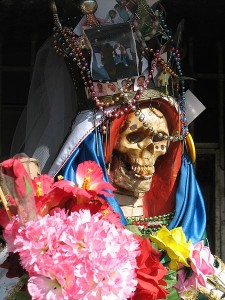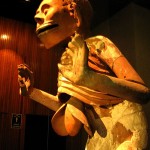
A few days ago, while I was out hiking in southern Arizona’s early morning heat with Jason De Leon and his students, I heard mention for the first time of Mexico’s Santa Muerte, or Saint Death. Our destination for the day was a small archaeological site hidden away in Arizona’s Coronado National Forest, but De Leon, an archaeologist and ethnographer at the University of Michigan, Ann Arbor, wanted to stop in first at a small outdoor shrine.
Hollowed out from the soft limestone, the shrine glittered with silvery scapulars, bright rosary beads, and large glass candles. A rough wooden cross leaned against the rock, and beneath it, pictures of saints lined the lower ledge–gifts from those craving divine assistance in the desert. And as I studied the faces of these unfamiliar saints, De Leon brought up the subject of Santa Muerte. She was, he explained, “the patron saint of all things seedy,” a saint loved by the marginal and the criminal in Mexico.
Stripped of all flesh and bearing a scythe in one hand, Santa Muerte bears a striking resemblance to the Grim Reaper–a walking nightmare. And yet, Santa Muerte has a gentle, kindly side. She accepts all those cast out by the Catholic Church–from gay men and women to drug dealers and prostitutes–and is said to work miracles on their behalf. Her legion of followers present her with unconventional offerings: cigarettes, cigars and marijuana.
The cult of Santa Muerte is particularly strong in one of Mexico City’s roughest neighborhoods, Tepito. Inhabitants there believe they are following the ways of their Aztec ancestors, who once worshipped a skeletal god known as Mictlantecuhtli. According to Aztec myth, this skeletal diety was the lord of the underworld, a god whose fierce ways matched his somber appearance.

Is Santa Muerte a modern folk version of this old Aztec god? When I was digging into the scientific literature today, I couldn’t find any direct link. But I did learn one interesting thing. Tepito, the home of so many of Santa Muerte’s devout worshippers, was a poor, marginal area even in early Aztec times. Perhaps its downtrodden residents kept the memory of their deathhead god alive quietly for hundreds of years, until a modern day underworld adopted her as its own.
Upper Photo: Close-up view of a Santa Muerte south of Nuevo Laredo, Mexico.
Lower Photo: Mictlantecuhtli, Museo del Templo Mayor, Ciudad de México. Photo courtesy of Pedro Sanchez.